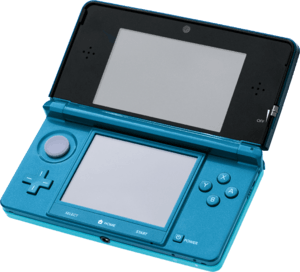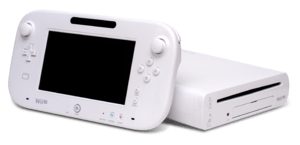2010s in video gaming
| 2000s . 2010s in video gaming . 2020s |
| Other events: 2010s . Games timeline |
The 2010s is the current decade of video gaming and the fifth decade in the industry's history. Thus far, the decade has become notable for producing the first truly "3D" games and consoles, introducing cloud gaming to consumers, and the rising influence of tablet-based and mobile casual games. The industry remains heavily dominated by the actions of Nintendo, Sony, and Microsoft, but it remains unforeseen how their dominance will be affected by the growing smartphone and tablet market.[1] A Yahoo article published in 2012 predicted that video game consoles will not be around in 2020, but will instead be built-in features to televisions.[2]
Consoles of the 2010s
Seventh generation consoles

The seventh generation of gaming consoles entered the market in the mid-2000s with the release of the Xbox 360, PlayStation 3, and the Nintendo Wii. These three consoles dominated the gaming scene throughout much of the early-2010s as well. Each console brought with them a new breakthrough in technology. The Xbox 360 offered games rendered natively at HD resolutions. In addition to HD games, Sony's PlayStation 3 featured a built in Blu-ray player. Nintendo, having opted out of the HD race, focused more on mobility and interaction. All three major consoles expanded their overall use by doubling as media centers, featuring Wi-fi internet connectivity, and allowing gamers to use apps.
Regarding the handheld market, Nintendo's evolving DS series of handhelds and Sony's PSP dominated the market throughout much of the late-2000s. The Nintendo DS introduced a dual screen, as well as touchscreen gaming. The PSP was Sony's first attempt at competing with Nintendo and featured multiple ports to other devices, improved graphics, and is known for being the first handheld gaming device to use an optical disc format.
Eighth generation consoles
The eighth generation of gaming consoles followed a longer than usual console cycle.[4] Nintendo was the first of the big three companies to announce their next generation console, doing so at E3 2011 with the unveiling of the Wii U, the successor to the Wii.[5] The Wii U was released in North America, Europe, Australia and New Zealand in November 2012 and in Japan the following month.[6] Reception to the console was mixed, with many reviewers criticising the limited choice of launch games available.[7]
Both Microsoft and Sony announced their offerings in the eighth generation in 2013. On May 21, just weeks before E3 2013, Microsoft revealed its "all-in-one entertainment device," the Xbox One.[8] Reaction among the press and gamers was mixed, with many gamers criticizing DRM-related restrictions and persistent internet requirements.[9] E3 in June saw Microsoft reveal a November launch date for the Xbox One[10] and Sony unveil its eighth generation console, the PlayStation 4. The Playstation 4 received an enthusiastic response from the attendees after it was revealed it would lack DRM restrictions and online requirements and have a cheaper launch price thean the Xbox One,[11] leading some commentators to declare Sony the winner of E3.[12] In the week following E3, Microsoft announced a reversal of the its online and used games restrictions after substantial negative feedback.[13]
Handheld gaming in the eighth generation was dominated primarily by the Nintendo 3DS and the PlayStation Vita. The Nintendo 3DS is the first gaming device to feature 3D gaming without the need for stereoscopic glasses.[14] Sony's Vita is the successor to the PSP. Both systems are backward compatible. Nvidia also announced its intention to market a handheld gaming device.[15]
The eighth generation consoles are expected to face stiff competition from tablet and smartphone gaming markets,[2] online services and dedicated consoles[16] based on cheap technology[17] and free-to-play games or low cost downloadable content[18] away from big budget blockbusters,[19] as well as an increased interest in independent games promoted by popular social networking sites.[20][21]
History
Impact of the Great Recession on the video game industry
The financial crisis that struck in the late-2000s has affected the gaming industry.[22][23] Many electronic gadgets, not just video games, were perceived to be a luxury item.[24] Also, market shifts towards mobile and casual gaming has led to a dip in overall sales as well.[25]
New Dimensions
Following the release of James Cameron's long-awaited Avatar film, utilizing 3D technology became a staple movement to see in the production and services of television, as well as video games.[26] Nintendo became the first gaming device to feature 3D visuals without the need for special glasses with the release of their 3DS handheld.
In a related trend, Sony unveiled "dual-view" at E3 2011. Dual view technology provides gamers the capability of playing multiplayer games on the same screen without splitting it by overlaying the two images on top of each other.[27]
Cloud-based and subscription gaming
Cloud gaming, or sometimes known as gaming on demand, is a technology in which the actual game and saved data is stored on a company's server, and users play the game over a stable internet connection. One major advantage to cloud gaming is the absence of a compact disc or cartridge required for use.[28][29] In 2010, the OnLive gaming console debuted becoming the first console to exclusively feature cloud-based gaming. As the decade progressed, even some of the major players began to look into utilizing cloud gaming into their systems.[30][31] Currently, it is the fastest-growing segment of the gaming market.[32]
In 2013, Julie Uhrman began a Kickstarter campaign to raise funding for her cloud-based gaming console, the Ouya.[33] The Ouya outdid their goal by raising over US$8.5 million, becoming that site's second-highest-earning project to that date. It operates with technology from Android, and features customization to the device's cover.[34]
During a press conference at the 2014 Consumer Electronics Show, Sony unveiled PlayStation Now,[35] which is a subscription-based streaming service that allows the PlayStation 4 to play previous console titles over the internet. As of February 2014, Now is in closed beta, but is planned to be released to the public later in the year.[36] Sony had recommended users to have at least a 5Mbps internet connection speed for what they termed "good performance."[37]
Cloud gaming is expected, by many video game experts, to challenge the dominance of the major video game corporations, and may eventually lead to the decline of console gaming entirely.[38][39][40]
Tablet-based, smartphone, and social networking gaming
The iPad, as revolutionary as it was to the tablet PC industry, has also had a lasting effect on the gaming world as well. Apple's trademarked retina display has set such a high bar on graphic capabilities that it could go head-to-head with some of the major handheld gaming devices.[41] In fact, nearly half of the Top-25, paid applications on the iPad are games.[42] Despite not having a controller, Apple products and mobile games will continue to become a staple of the "casual gaming" market.[43]
Mobility

Ever since Nintendo released the original Wii in 2006, mobility and interaction became a major innovation to the gaming world. It encouraged activity with gaming beyond the traditional controller, and expanded the market to include the elderly and those interested in physical therapy.[44][45][46][47] Microsoft and Sony did not respond to Nintendo's motion sensor technology until 2010 when they released Kinect and PlayStation Move, respectively. The Kinect took further advantage of motion control by not requiring a controller at all.[48][49][50]
In late-September 2012, Yosh Engineering unveiled its new immersive motion capture, virtual reality program.[51] The company will showcase this feat further at a conference in November 2012.[52] The YEI 3-Space Sensor product line featured allows for highly accurate body and head tracking giving the wearer full freedom of mobility in a realistic virtual environment.[53] In a video posted to YouTube, Yosh Engineering showed that the technology is both easily adaptable to modern graphic requirements (for the demonstration they used the Unreal graphics engine[54]) and that the wearer has a freedom to move about through this 3D space.
In 2013, a Houston-based upstart named Virtuix began a Kickstarter campaign to develop the Omni, an omnidirectional treadmill that has potential applications for video games. Such a device, if ever released to the public, would allow a player to walk naturally in the virtual environment of a game.[55]
Violence debate is revived
In the aftermath of several mass shootings, namely the Aurora, Colorado theater shooting and the Sandy Hook Elementary School shooting, debate on whether or not there is a connection between violent video games and real-life violent acts re-emerges.[56][57][58] United States President Barack Obama assigned his Vice President, Joe Biden, to head a discussion with representatives for the media, gun, and video game lobbies in early-2013.[59][60] Several days later, Obama announced stricter legislation on guns and also proposed a $10 million study, to be headed by the CDC, on whether or not violent video games were encouraging violent behavior.[61]
Demographics
According to the Entertainment Software Association, the average age of a person who plays video games in 2010 is 30.[62]
Notable video-game franchises established in the 2010s
- Amnesia (2010)
- Awakening (2010)
- Binding of Isaac (2011)
- Clash of Clans (2012)
- Dana Knightstone (2010)
- Dance Central (2010)
- Dark Souls (2011)
- Destiny (2014)
- Dishonored (2012)
- Disney Infinity (2013)
- Five Nights at Freddy's (2014)
- Fluidity (2010)
- Homefront (2011)
- Hyperdimension Neptunia (2010)
- Jisei (2010)
- Metro (2010)
- Minecraft (2011)
- Skylanders (2011) 2
- Slender (2012)
- Sniper: Ghost Warrior (2010)
- Temple Run (2011)
- Tearaway (2013)
- Titanfall (2014)
- Toy Soldiers (2010)
- The Walking Dead (2012)1
- Watch Dogs (2014)
Notes:
- 1Game franchises that also accompany major film or television franchises.
- 2Game franchises that are considered spin-offs of previously established franchises.
In popular culture
- In the 1989 film Back To The Future Part Two, protagonist Marty McFly is sent into his future 2015, enters a 1980s-themed bar and encounters two children trying to figure out how to operate an old arcade game. When Marty gets the arcade game working, the kids react negatively describing a game that requires a player to use their hands as a "baby game."[63]
- Tron: Legacy is released in 2010, and is a sequel to the 1982 film Tron, a film that takes place within the digital world of a video game.[64]
- The 2012 film, Wreck-It Ralph centers on a video game villain who wishes to be a hero.[65] Many references and cameos to other video games are present throughout the film.[66]
- Frank Underwood, the protagonist in the Netflix political drama House of Cards (2013–present) is an avid video gamer, and is often seen playing games like Call of Duty and mobile games in his spare time.[67]
Hardware timeline
The following gallery highlights hardware used to predominantly play games throughout the 2010s.
-

iPad (2010) and other tablet-PCs
-

Playstation Move (2010), accessory for the Playstation 3.
-

Kinect (2010), accessory for the Xbox 360.
-

Nintendo 3DS (2011)
-

Nintendo's Wii U (2012)
-

Ouya microconsole (2012)
-

Oculus Rift VR-display (2012), accessory.
-

Sony's Playstation 4 (2013)
-

Microsoft's Xbox One (2013)
-
.jpg)
Virtuix Omni (Planned for 2014), accessory.
See also
- 2000s in video gaming
- 2010 in video gaming
- 2011 in video gaming
- 2012 in video gaming
- 2013 in video gaming
- 2014 in video gaming
- 2015 in video gaming
- 2016 in video gaming
- List of video games in development
References
- ↑ Keith Stuart (2011-12-28). "Games in 2012: Sony, Microsoft and Nintendo consoles face crunch time | Technology". London: The Guardian. Retrieved 2012-03-09.
- 1 2 7 Gadgets That Won't Be Around In 2020 (18 October 2011). The Street. Retrieved 18 September 2013.
- ↑ "Consolidated Sales Transition by Region" (PDF). Nintendo. 2014-01-28. Retrieved 2014-01-29.
- ↑ Campbell, Colin (26 November 2012). "Has the longest console generation damaged gaming?". IGN. Retrieved 12 November 2013.
- ↑ Burns, Matt (7 June 2011). "The Nintendo Wii U Won E3 2011". TechCrunch. Retrieved 20 September 2013.
- ↑ Goldfarb, Andrew (13 September 2012). "Wii U Price, Release Date Announced". IGN. Retrieved 12 November 2013.
- ↑ Plant, Michael (6 December 2012). "Wii U – Review of reviews from around the web". The Independent. London. Retrieved 12 November 2013.
- ↑ Guarini, Drew (21 May 2013). "Xbox One, Microsoft's Next Generation Console, Unveiled At Event In Redmond". The Huffington Post. Retrieved 20 September 2013.
- ↑ "Xbox One: Microsoft defends pre-owned games rules". BBC News. BBC. 7 June 2013. Retrieved 12 November 2013.
- ↑ Molina, Brett (10 June 2013). "Xbox One out this November for $499". USA Today. Retrieved 12 November 2013.
- ↑ Tassi, Paul (11 June 2013). "PS4's Price And Policies Humiliate Microsoft's Xbox One At E3". Forbes. Retrieved 12 November 2013.
- ↑ Stuart, Keith (11 June 2013). "E3 2013: Xbox One v PS4 heavyweight clash dominates day one". The Guardian. London. Retrieved 12 November 2013.
- ↑ Greene, Jay (19 June 2013). "Microsoft pulls a 180, reverses Xbox One always-on DRM and used games policy". CNET. Retrieved 12 November 2013.
- ↑ "Launch of New Portable Games Machine" (PDF). Nintendo.co.jp. Retrieved 6 October 2014.
- ↑ "Nvidia announces own 'Shield' gaming device at CES". CNET. Retrieved 6 October 2014.
- ↑ "8th Generation Wars: A 'Console' Challenger Appears". Gamasutra. Retrieved 6 October 2014.
- ↑ "Online Gaming 'Reduces Likelihood Of 9th Console Generation'". Gamasutra. Retrieved 6 October 2014.
- ↑ Ralph Barbagallo. "We Need The Greatest Generation of Gamers To Save The Future Of Gaming". Kotaku.
- ↑ "Capcom: The Next Gen Doesn't Start With Wii U". Nintendo Life. Retrieved 6 October 2014.
- ↑ Alpeyev, Pavel (2011-06-19). "Nintendo May Fail to Replicate Wii Success as IPhone Games Bloom". Bloomberg. Retrieved 2012-03-09.
- ↑ "Facebook Gaming: 10 Facebook Games Stats | Digital Buzz Blog". Digitalbuzzblog.com. 2011-02-07. Retrieved 2012-03-09.
- ↑ Richtel, Matt (2009-06-11). "Video Games Aren't Recession-Proof - NYTimes.com". Bits.blogs.nytimes.com. Retrieved 2012-03-09.
- ↑ "So much for recession-proof: U.S. video game sales take a 17 percent dip in March". VentureBeat. 2009-04-16. Retrieved 2012-03-09.
- ↑ "In a recession, tech gadgets become a luxury". CNN. 2009-03-02. Retrieved 2012-03-09.
- ↑ "The Video Game Recession - 24/7 Wall St". 24/7 Wall St. 2012-01-13. Retrieved 2012-03-09.
- ↑ Bertolucci, Jeff (2009-12-20). "Avatar: Good News for 3D TV and Blu-ray?". PCWorld. Retrieved 2012-03-09.
- ↑ "Sony demos dual-view TV, allows two channels on one set simultaneously – New Tech Gadgets & Electronic Devices". Geek.com. 2011-02-22. Retrieved 2012-03-09.
- ↑ Ivan, Tom (2011-09-08). "News: Consoles to dump discs for cloud gaming, says THQ boss". ComputerAndVideoGames.com. Retrieved 2012-03-09.
- ↑ Yin, Wesley (2011-09-08). "THQ: future consoles will dump discs News • News •". Eurogamer.net. Retrieved 2012-03-09.
- ↑ "Sony, Microsoft and Nintendo Taking to the Cloud". GAMElitist.com. Retrieved 6 October 2014.
- ↑ Rosenberg, Dave (2010-07-13). "Nintendo chief on gaming and the cloud | Software, Interrupted - CNET News". News.cnet.com. Retrieved 2012-03-09.
- ↑ Sassoon, Alex (2012-01-17). "Sega: Cloud gaming is market's fastest-growing segment". GameSpot.com. Retrieved 2012-03-09.
- ↑ "How OUYA Created a Trending Brand in Less than a Day". Momentummediamarketing.com. Retrieved 6 October 2014.
- ↑ Alex Wawro (11 July 2012). "Why Ouya Is Making A Killing On Kickstarter". PCWorld. Retrieved 6 October 2014.
- ↑ "PlayStation Now game-streaming service coming summer 2014 (update)". Polygon. Retrieved 6 October 2014.
- ↑ "Sony goes all-in on cloud with game, TV streaming". CNET. Retrieved 6 October 2014.
- ↑ "PlayStation Now Recommends 5Mb/s Connection". IGN. Retrieved 6 October 2014.
- ↑ "OnLive on Google TV: The death of the games console?". Electricpig. 2012-01-12. Retrieved 2012-03-09.
- ↑ "Richard Garriott predicts the death of consoles as a gaming medium". Massively. Retrieved 6 October 2014.
- ↑ "Gaikai Predicts Death Of Game Consoles". WebProNews. Retrieved 6 October 2014.
- ↑ "The new iPad and gaming: What will change?". CNET. Retrieved 6 October 2014.
- ↑ Caulfield, Brian (7 March 2012). "Apple's New iPad Compared To XBox 360, PlayStation 3". Forbes. Retrieved 6 October 2014.
- ↑ Archived March 11, 2012, at the Wayback Machine.
- ↑ Archived February 11, 2012, at the Wayback Machine.
- ↑ "Video Games a Good Supplement to Physical Therapy for ICU Patients". Gamepolitics.com. Retrieved 6 October 2014.
- ↑ "Elderly gamers 'fall less'". Sciencealert.com. Retrieved 6 October 2014.
- ↑ "Elderly gamers take to Wii system's physically active controls / LJWorld.com". Ljworld.com. Retrieved 6 October 2014.
- ↑ ""MIT" The 50 most innovative companies 2011, MIT technological review". MIT Technology Review. Retrieved 6 October 2014.
- ↑ Takahashi, Dean (September 5, 2009), "How many vendors does it take to make Microsoft's Project Natal game control system?", Venture Beat, retrieved January 8, 2010
- ↑ Press, MS (March 31, 2010). "PrimeSense Supplies 3-D-Sensing Technology to Project Natal for Xbox 360". MsPress. p. MsPress. Archived from the original on 2010-06-20. Retrieved March 31, 2010.
- ↑ "YEI creates first person virtual reality demo with full body tracking". Telepresenceoptions.com. Retrieved 6 October 2014.
- ↑ Archived December 13, 2012, at the Wayback Machine.
- ↑ "Take control of a Gears of War locust with this VR gaming setup". TechHive. 10 October 2012. Retrieved 6 October 2014.
- ↑ "Full-body, real-time motion tracking achieved using 17 sensors, Unreal Engine - Games - Geek.com". @geekdotcom. Retrieved 6 October 2014.
- ↑ Tweedie, Steven (June 3, 2013). "This Virtual Reality Treadmill Could Be The 'Holy Grail' Of Video Game Controllers". Business Insider. Retrieved June 17, 2013.
- ↑ Kris Graft. "Gamasutra - Two bills target video games following Sandy Hook tragedy". Gamasutra.com. Retrieved 6 October 2014.
- ↑ "Guns, Violence, Video Games, Irrationalism and the NRA's Tedious New iOS App". TIME.com. 15 January 2013. Retrieved 6 October 2014.
- ↑ LeJacq, Yannick (2012-12-21). "After Sandy Hook, Should Violent Video Games Call a Cease-Fire?". The Wall Street Journal.
- ↑ "Will Biden target violent video games? (And should he?)". MSNBC. Retrieved 6 October 2014.
- ↑ "ABC7 News - KGO Bay Area and San Francisco News". ABC7 San Francisco. Retrieved 6 October 2014.
- ↑ "Obama Asks Congress to Commission Violent Games Study". IGN. Retrieved 6 October 2014.
- ↑ "The Entertainment Software Association". Theesa.com. Archived from the original on 28 November 2014. Retrieved 6 October 2014.
- ↑ "Back to the Future Part II (1989)". IMDb. Retrieved 6 October 2014.
- ↑ "TRON: Legacy (2010)". IMDb. 17 December 2010. Retrieved 6 October 2014.
- ↑ "Wreck-It Ralph (2012)". IMDb. 2 November 2012. Retrieved 6 October 2014.
- ↑ Matt Patches (5 November 2012). "How 'Wreck-It Ralph' Unlocked Its Unbelievable Cast of Video Game Legends". Hollywood.com. Retrieved 6 October 2014.
- ↑ Myles Tanzer (4 March 2015). "'House of Cards' just sent this indie game to the top of the App Store". The Daily Dot. Retrieved 16 November 2015.